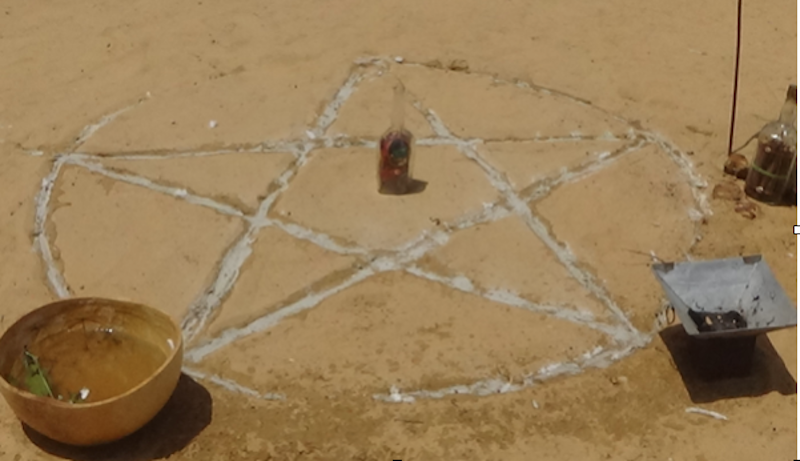T H E M A T R I A R C H A L H I S T O R Y O F W E S T A F R I C A
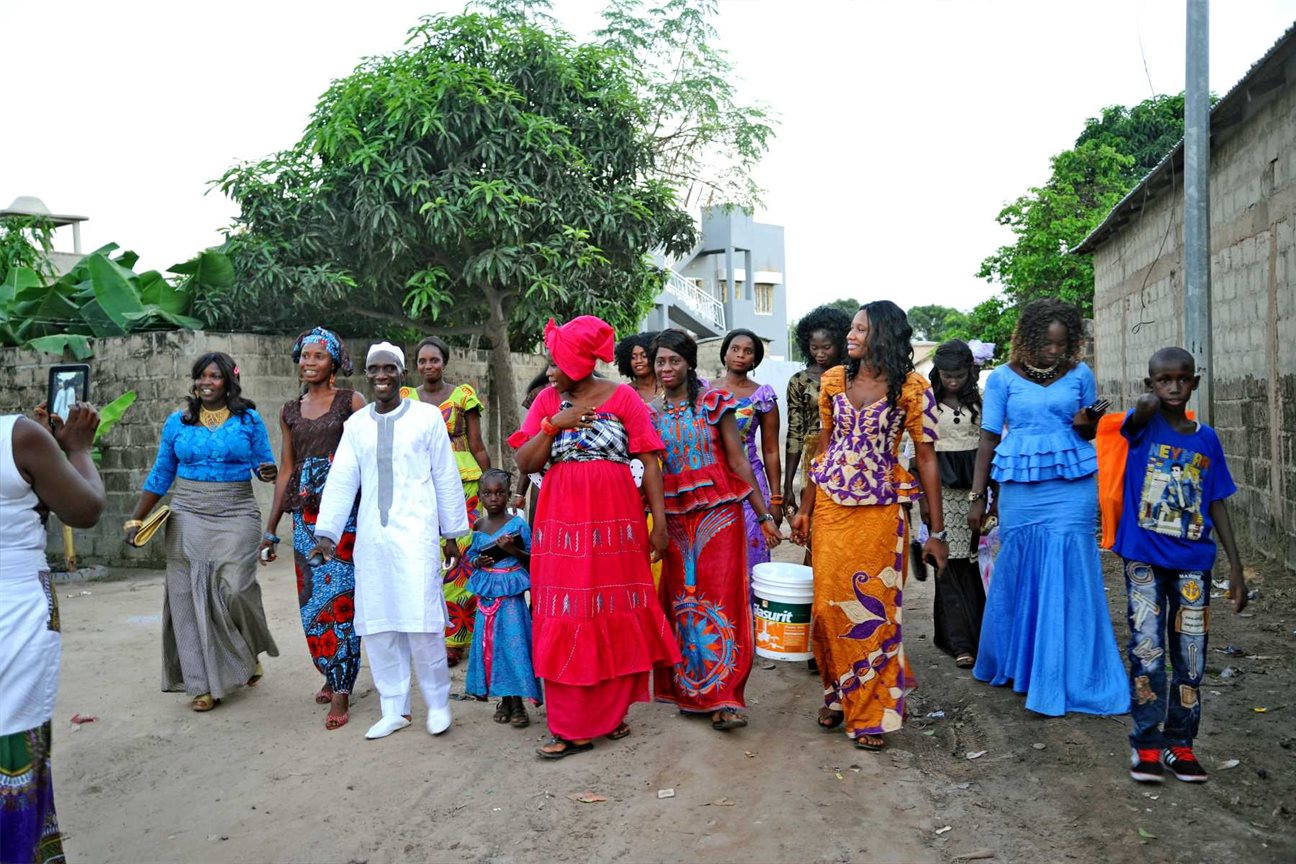
As I already have mentioned in the pages about me, my partner / brother Issa is brought up in a matriarchal society in Gambia in West Africa. This didn´t appear to me though, before we had known each other for quite a while, as he himself never thought of it as something remarkable, his extended matriarchal family being as natural to him as the opposite to us; the nuclear patriarchal one. When he one day however, started to talk about his mothers brothers, and not his father, as the legal guardians for his upbringing and his initiation, I all of a sudden realised what it was about, as I already by then was quite well informed about the fundamental characteristics of a matriarchal society. And since then I have had lot of occasions to learn more about his society and culture and the way it has molded his personality and worldview. The latter is still quite different from our Western one, although he came here as a young man, only 17 years old in the 70s, and thus has lived here for some fourty years.
And surprisingly much thereof, not at least the strong urge to hold ones mothers, aunts and grandmothers in high esteem, I can recognise in my investigations of the West African matriarchal societies as well as the other African such, especially the features being described by Jerome Lewis as characteristic for the hunter and gatherers living in the African and Asian rainforests, not at least the one of re-enacting others behaviour in a humouristic way skilfully mimicing their facial expression and body language, if they have done something foolish. He also often reminds himself, not without a certain kind of delight and humous laughter, how the women, if the men had misbehaved, actually punished them therefore physically, first taking a challenging position and thereafter pulling up their long skirts around there knees, I suppose in some kind of symbolic gesture, and then took a grip on the man´s waist and just throwed him away.
It is obvious that many of the typical strategies in achieving and managing a peaceful and egalitarian system in the hunter and gatherer societies, continue to make up an integrated part of the fundamentally religious or spiritual ethos of the great confederation of peacefully intertwined matriarchal clans, held together by a Queen Mother who supervised her queendom from INSIDE - OUT and / or BOTTOM-UP, encouriging the unfolding of new matriarchal clans, all of them in their turn led by clan mothers / priestesses or sacred matriarchs who made up the council of the primeval Great Queen Mother - constituting an increasingly complex system, the more it expanded from smaller villages to cities and eventually to great realms of queendoms.
Peaceful and egalitarian matriarchies achieved by:
ANARCHICAL EMERGENCE FROM INSIDE- OUT / BOTTOM-UP
INSTEAD OF TOP-DOWN SUBJUGATION
It is obvious that many of the typical strategies in achieving and managing a peaceful and egalitarian system in the hunter and gatherer societies, continue to make up an integrated part of the fundamentally religious or spiritual ethos of the great confederation of peacefully intertwined matriarchal clans, held together by a Queen Mother who supervised her queendom from INSIDE - OUT and / or BOTTOM-UP, encouriging the unfolding of new matriarchal clans, all of them in their turn led by clan mothers / priestesses or sacred matriarchs who made up the council of the primeval Great Queen Mother - constituting an increasingly complex system, the more it expanded from smaller villages to cities and eventually to great realms of queendoms.

This kind of selfgenerating, selfimitating and selfregulating process reminds a lot of the overall processes in the organic nature at a microcosmic as well as in macrocosmic ones; The unfolding of the fibonaccirelated spiral of a selfimitating fractal repeating itself over and over again in endless chains of beautiful combinations, making up increasingly complex structures over space and time. I will return to this complex structure that opposes the TOP-DOWN kind of society that´s imposed upon people of the faboulous wealthy, well organised and religiously very sophisticated society of Ghana in the beginning of the Middle Ages on this page:
THE HISTORY OF AKAN / ASHANTE / GHANA
ISSA´S WEST AFRICAN CULTURE AND HISTORY / GAMBIA SENEGAL
This is the way Issa lived as a young boy; going out on the see together with his elder brother and cousins to fish in this kind of lanky and simple boats, which sometimes could be very dangerous, especially when the big foreign trawlers that overfish the waters around the coasts in West and East African tried to ram their boat, when they were asking for a share of their catch. Nowaday the West African peoples suffer from a lack of their former staple food; fish, as the foreign trallers by Westernes and Chineses who don´t seem ashamed of taking the food out of the mouth of the poor.
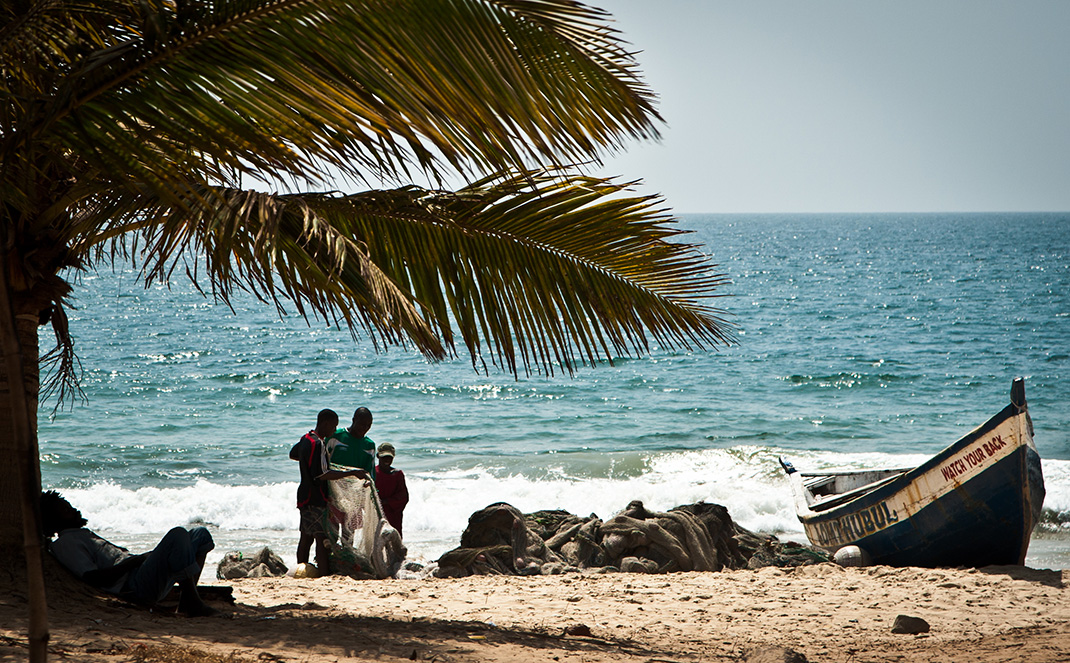
Since the day I understood that Issa´s Serer-Wolof extended family was matriarchally organised, I have been looking for research about these people but haven´t yet suceeded to find so much. I suppose the famous Senegalese ethnologist Cheik Anta Diop has carried out some, and will look that up later. Besides, the Nigerian born anthropologist /sociologist Ifi Amadiume, although admitting her having much to be thankful to this great scholar for, makes some complaints about him following the Western example, by furthering ethnologist research from the TOP - DOWN perspective, too much focusing on the powerful noble families, even though admitting also them being matriachal, she is of the opinion that his TOP-DOWN perspective is on behalf of the of daily life among common people still living their traditional African lives out on the countryside, which she consider to a great extent having been matriarchal and still is even today. She also regrets the fact that many of the modern indigenous African ethnologists and historians follow this primeval patriarchal Western tradition of focusing on the TOP-DOWN perspective.
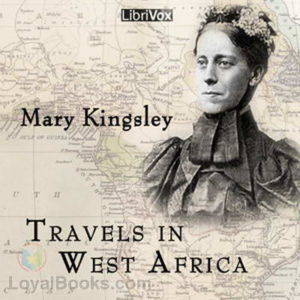 In fact the only thing I have succeeded to find about that yet, is some short lines by Mary Kingsley, about the close ties between mothers and their sons, stating that women and men didn´t seem to have as close ties to their married partner´s as to their sons and brothers /sisters / mothers, which is a clear sign of a matriarchal organisation, as well as in some of the famoius panafricanist Henry Clarkes lectures on Youtube. I find this lack of interest in Issa´s culture and history remarkable, as the things he has to tell are so very interesting, revealing a typical matriarchal society in all the aspects included in Heide Göttner Abendroths definition of a such. Beyond that, West African culture is very rich in music and dance and overall aesthetic expressions and beauty in art as well as in philosophy and an ancient history, which not at least has come forth in the history re-writing among the intellectual Africans, Afro-Americans and Carrebean panafricanists such, as for example the famous scholars Henry Clarke and Lerone Bennett. But none of them, as far as I know, has been writing specifically about the Serere -Wolof peoples or about the way the matriarchies were structured and more specifically influenced African culture, even though they don´t omit to mention the matrilineal traditions and their impact on men´s and women´s lifestyle in common, seeming proud of the strong and selfindependant African women. Most of the West African historywriting is about the great Akan, Mossi and Ashanti realms, and later the muslim Songhai and Mali empires as well as the kingdoms of Benin and Dahoomey.
In fact the only thing I have succeeded to find about that yet, is some short lines by Mary Kingsley, about the close ties between mothers and their sons, stating that women and men didn´t seem to have as close ties to their married partner´s as to their sons and brothers /sisters / mothers, which is a clear sign of a matriarchal organisation, as well as in some of the famoius panafricanist Henry Clarkes lectures on Youtube. I find this lack of interest in Issa´s culture and history remarkable, as the things he has to tell are so very interesting, revealing a typical matriarchal society in all the aspects included in Heide Göttner Abendroths definition of a such. Beyond that, West African culture is very rich in music and dance and overall aesthetic expressions and beauty in art as well as in philosophy and an ancient history, which not at least has come forth in the history re-writing among the intellectual Africans, Afro-Americans and Carrebean panafricanists such, as for example the famous scholars Henry Clarke and Lerone Bennett. But none of them, as far as I know, has been writing specifically about the Serere -Wolof peoples or about the way the matriarchies were structured and more specifically influenced African culture, even though they don´t omit to mention the matrilineal traditions and their impact on men´s and women´s lifestyle in common, seeming proud of the strong and selfindependant African women. Most of the West African historywriting is about the great Akan, Mossi and Ashanti realms, and later the muslim Songhai and Mali empires as well as the kingdoms of Benin and Dahoomey.

Serer-women living in Senegal and Gambia
So, once having discovered my Issa´s matriarchal background, I set out looking for information online about matriarchies in Africa. But instead I came upon a lot of male stream biased ideas about "avunkulat" promoting the opinion of male dominance ruling even in matrilineal societies. Thus; Although women are the ones who supervise everything and stand as the owner of the land and compounds of their motherclan, and serve as the leaders of the religious ceremonies and beliefs, that they have created themselves, Western Scholars religious believe is that men still do rule everything, based on the superstitious idea that their supernatural abilitity to wield powe is made up by magic.
So then one day I asked Issa, if in his family it was his uncles who were the ones who took the decisions. And as he without any hesitation instantly answered - Yes of course!, I felt deceived and burst out: - Now, why this, all of a sudden, when you´re otherwise always talking about your mother being the one who did the supervising and governing of everything with such a firm hand?
Then he just despairingly shook his beautiful dreadlooks, took a deep breath and sighed: - Oh you folks with your crazy gender ideas and things. Don´t you understand that they were the same!
This occasion came to my mind when I read this passage in Evelyn Reed´s classical work: Women´s Evolution; Matriarchal Clan to Patriarchal family 1976, a very interesting work I highly can recommend, as one of the first I read in the subject of matriarchy after Elin Wägner´s Väckarklocka .
(my transl. from the Swedish)
"Max Gluckman writes, that the Barotse-people in Africa classifies the uncle together with his sister, calling him a `male mother´:
When I was working in Barotseland during the war, I was told by a newly employed governor over the district, that he had had a request by a soldier in the army, who wasn´t in time when coming back from his permission. The soldier excused himself, by referring to the fact that his mother had died when he was at home, and he had to visit the funeral. But the governor had discovered that it was the soldier´s uncle who had died. I explained that the Barotse people calls the uncle `male mother´or simply `mother´. The uncle was a very close relative, whose funeral a man must attend. The governor then wrote to the army: -Ask the soldier if his mother was a woman or a man. If he says that that the mother was a woman, he lies, but if he says that the mother was a man he´s telling the truth. /Custom and Conflict in Africa s. 62)
In the language Issa speaks; Wolof, the word for mother is "jay" and the word for uncle "nijay".

THE HISTORY OF ISSA´S SERER-WOLOF PEOPLE´S LONG-TERM FIGHT
AGAINST THEIR PATRIARCHAL PURSUERS
This is Issa´s Grandmothers Grandfather; Alboury Njie- a Famous Warrior from the Battle of Somb in Senegal 1867
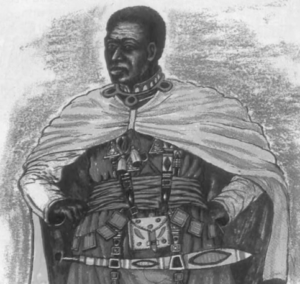 The map of West Africa constantly changed during the Middle Ages - from the first great, incredibly rich and well organised realms created by the matriarchal Akan clans in the queendoms called Ghana and Mali in the beginning of the Middle Ages, to the later glorious empire of Songhay, eventually ruled by the intruding muslim Arabs, together with the indigenous Africans from Sudan, whome they have succeded to convert to islam. Whereas those who refused giving up their own traditional African matriarchal customs and beliefs, had to flee increasinly further westwards from the inner parts of Sahel to the West African coastline, as the aggressive patriarchal muslims pushed forward. Some of them even had to move out to the Bijagos islands outside the coast of Guinea Bisseau - i. e. the same old story as everywhere else on this earth where the matriarchal peoples have had to flee their patriarchal persuers into remote areas high up in the mountains or out in the desert (as for examople the Tuaregs who initially lived along the coastline in Libya), or even out on the see trying to find new lands on islands far away outside the mainland coast as was the case in China, Southeast Asia and the Pacific Ocean.
The map of West Africa constantly changed during the Middle Ages - from the first great, incredibly rich and well organised realms created by the matriarchal Akan clans in the queendoms called Ghana and Mali in the beginning of the Middle Ages, to the later glorious empire of Songhay, eventually ruled by the intruding muslim Arabs, together with the indigenous Africans from Sudan, whome they have succeded to convert to islam. Whereas those who refused giving up their own traditional African matriarchal customs and beliefs, had to flee increasinly further westwards from the inner parts of Sahel to the West African coastline, as the aggressive patriarchal muslims pushed forward. Some of them even had to move out to the Bijagos islands outside the coast of Guinea Bisseau - i. e. the same old story as everywhere else on this earth where the matriarchal peoples have had to flee their patriarchal persuers into remote areas high up in the mountains or out in the desert (as for examople the Tuaregs who initially lived along the coastline in Libya), or even out on the see trying to find new lands on islands far away outside the mainland coast as was the case in China, Southeast Asia and the Pacific Ocean.
Issas matrilineal ancestors by then ruled the little land that´s colored light green on the map below, in nowadays Senegal, called "Sine". (Perhaps they had increased their territory in the 19th centrury - that I don´t know) And his grandmothers grandfather was the great and much honoured hero Alboury Sainabou Njie, King of Jolof, (wolof) who took part at and was killed in the famous Battle of Fandane-Thiouthioune 1867, also called the Battle of Somb, and is still today often extolled by the Griots and also by the worldfamous singer Youssun Dour himself, dressed up like his famous ancestor.
The Battle of Somb was a religious war between the Serer people and the Muslim Marabouts of the 19th century in Senegal and The Gambia, but it also had a political and economic dimension to it. The muslim Marabouts aim was to force the Serer people to convert to Islam, but they stubbornly resisted to do so up until modern times, making up the most noble, proud and cultivated people in Senegal and Gambia.
Issa, during his upbringing, often heard his relatives telling stories about female ancestors who had taken part in the battles against the muslim intrudors, persistently refusing to convert to Islam, revealing the same strong tendency as many other historical reports from this time; that it chiefly seems to have been female warriors and Queens who most energetic propagated for military defense against the intruders, of as well Arabs and other Muslims, as later European colonisers.
There are quite a few intricate problems connected with the research about the origins of the different African cultures, not at least since the passing down of history have remained oral up until recent times. That must not always be a disadvantage though, as these oral traditions have been connected to a strong and deep veneration of the ancestors and therefore maintains different kinds of effective memory techniques to keep their memory alive for centuries and sometimes even for thousands of years. Western history writing / anthropology and ethnology at the other hand, has, beyond its narrow-minded patriarchal elitist and capitalist /colonialist TOP - DOWN perspective, been deeply ingrained with prejudices about the inferiority of the “black man” and mostly being busy with denying the Africans of having any history at all. And according to the normally ignorant and vain endeavour of clapping with only one hand in our Western male stream culture and science, naturally African women haven´t been reckoned with as agents on the social arena at all.
Also Lerone Bennett Jr has a passage in the first chapter of his book Before the Mayflower; a History of Black America 1987, telling about the female Kandake rulers in Kush.
T H E I N C R E D I B L Y W E A L T H Y A N D G L O R I O U S
M A T R I A R C H A L C I V I L I S A T I O N S I N W E S T A F R I A
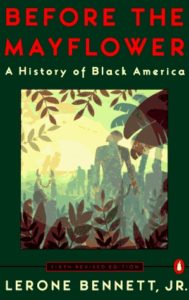 Lerone Bennett writes in his Before Mayflower; a History of Black America, that the European penetration and the slave trade debased much of that which was vital and in African culture. Its popular narrative of itself depicts the conquering Europeans carrying the blessings of the civilisation to naked savages sitting under the trees, filing their teeth and waited for fruits falling down into their hands, but the truth is less flattering for this European ego, he says. Quite the contrary on the West coast of Africa, from where most of the ancestors to the Afro- American blacks came, he writes:
Lerone Bennett writes in his Before Mayflower; a History of Black America, that the European penetration and the slave trade debased much of that which was vital and in African culture. Its popular narrative of itself depicts the conquering Europeans carrying the blessings of the civilisation to naked savages sitting under the trees, filing their teeth and waited for fruits falling down into their hands, but the truth is less flattering for this European ego, he says. Quite the contrary on the West coast of Africa, from where most of the ancestors to the Afro- American blacks came, he writes:
“There were complex institutions ranging from extended family groupings to village states and territorial empires. Most of these units had all the appurtenances of a modern states - armies, courts, and internal revenue departments. Indeed more than one scholar had payed tribute to “the legal genius of the Africans”.
Anthropologist´Melville J. Herskowits said that “Of the areas inhabited by nonliterate peoples, Africa exhibits the great incidence of complex governmental structures. Not even the kingdoms of Peru and Mexico could mobilise resources and concentrate power more effectively than could some of theses African monarchies, which are more to be compared with Europe of the Middle Ages, than referred to the common conception of the `primitive´ state.”
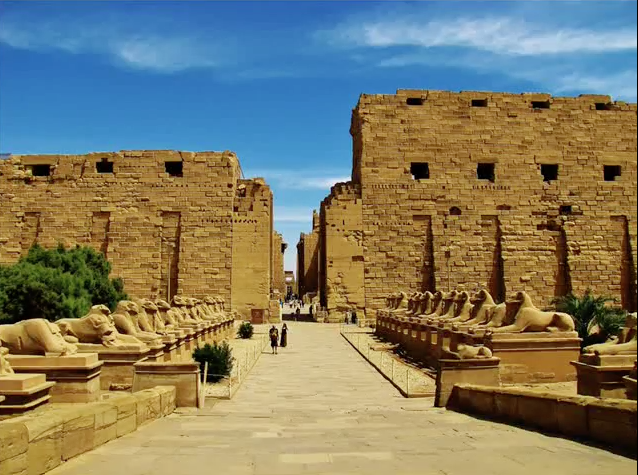
Medieval buildings in Ghana
Agriculture was the basis of the economic life, although herding and artisanship were important. Specialization was advanced, with one nation for example, concentrating on metallurgy and bartering with another nation which specialised in weaving or farming. A money system based on cowrie shell was in use before European penetration. Contemptuous of the concept of private property, West Africans believed that the land belonged to the community and could not be alienated.
Iron was known and used from the Atlantic ocean to Ethiopia. With simple bellows and charcoal fires the Africans smelted iron and manufactured beautiful implements.
The famous anthropologists Franz Boas said that "...a time when the Europeans were still satisfied with rude stone poles, the Africans had already invented or adopted the art of smelting iron… it seems not unlikely that the people who made the marvellous discovery of reducing iron ores by smelting were the African negroes. Neither ancient Europe, nor ancient western Asia, nor China knew iron, and everything points to its introduction from Africa.”
Lerone Bennett continues: “The core of West Africa society was family, which was organised in some tribes on a matrilineal basis - that is, decent were traced through the mother. Polygamy was common., although in practice, the poor, like poor people everywhere contended themselves with monogamy. Social life was well organised. The old the sick the informed were cared for. Spinsters were rare; prostitution were unknown. (Here Mr Bennet reveals a great lack of understanding of how matrilineality works as it has no place for the phenomenon; “spinsters”, as women are not economically dependant on husbands but makes up a productive part of their extended matrilineal family clan, my comment) Some nations incidentally, were acquainted with the allegedly modern practice of birth control. Bantu people said it was not good for a woman to give birth to more than one child in a three-year period. Some nations vaccinated for smallpox and said there was a cause and effect relation-ship between the mosquito and malaria. A European traveller in Abyssinia reported that “the Natives hereabouts say that Malaria is caused by the bite of Mosquito, but, of course we know better - it is caused by the miasmas of the swamps!”
Competition vs cooperation in matriarchal societies
As I once had a discussion with a friend online who expressed the suspicion of matriarchal socities being too much ”communistic” in the sense that they wouldn´t accept people to obtain their full potential by the kick it may give you to compete, this was what I answered:
I quite agree on the idea that a certain degree of competition might be benevolent; but it is as with everything else; it depends on the success of obtaining the optimal balance between the two Yin - and Yang poles.
In physical activities it may become visible that there is a fluent continuum between dancing and fighting - most clearly expressed in for example tango versus boxing. Tango has an element of fight / resistance in it - and boxing an element of dancing / giving in. The more the pooles diverges the more the tension / drama / creativity increases until the break of the perfect balancing point and collapse. This is the standard pattern in physics also taken into account in the balance act of bicycling, and the overall selfgenerating and self regulating spiraling in organic processes in life as for example wind-or waterwhirls and so forth.
When there is no tension at all: the move inhibits - and creativity cease = stagnation / death.
In Western philosophy there is a tendency of differentiating the phenomena in binary oppositional EITHER - OR - terms, which must be regarded as most inadequate, as you might as well do it in BOTH- AND-terms, and its the latter which are compatible with the processes in the organic realms, and most probably therefore also make up the fundamental basis for human brainwork and the socio-cultural realms. Why wouldn't culture and nature mirror each other instead of being regarded as “binary oppositions” as in Claude Levi Strauss theorising? And why wouldn´t the human brain and consciousness function according to the same fundamental principles as the rest of the overall organic processes in the world and cosmos?
I also think that the most fundamental prerequisite for the individuals to obtain courage and selfconfidence enough not to duck before challenges, is a safe and happy childhood with a lot of affirmation. (But yet again - not too much either - must be balanced not to spoil the child - to a certain degree children must learn to endure critics as well)
I also think that in Western male stream science / philosophy there is a biased idea about so called peoples in “primitive” societies being “collectively” instead of ”individualistic” disposed.
Today Issa was looking at this video of the people at home in Gambia dancing, and with your comment in mind, I then asked him about their attitude to competition when dancing together like this and showing off one by one in front of the audience gathered in a circle around them.
In the video above "Bona Camara plays Dunumba" you can watch this wonderfully generous and strong people dancing the way they do like really professional dancers and acrobats all of them, although they are but ordinary people as you and me. Women and men dancing in the same way with the same kind of movements and together with each other, or alone - some European white girls there too who probably have taking lessons in order to learn how to perform this quite difficult kind of dancing movements and so exhausting, phuuuu!!! Every little move in the neck, hips, knees, arms, elbows, fingers, backs, follows certain distinguished rhythmical patterns comprising long chains of differentiated rythmic events that everybody have ingrained in their whole systems, but takes weeks and months for Western proffsdancers to memorise.
In the beginning you can see a disabled man dancing - totally normally as everybody else - no-one finding him different from the other. Quite the contrary he expresses himself freely on the same terms as them.
Then you can see people challenging each other by showing off the best they can in front of each other - and I always thought that this kind of performance comprised an element of competition so I asked Issa about that today
But he denied that notion very firmly. No no he said; if you try to show off as better than others you get a very bad response and people will despise you. Its not about that but to show admiration for one another, he said.
The well known Swedish author at about my age; Kerstin Thorwald, who is now gone, was a woman who had a great appetite on sex, which actually seemed quite neurotic to mee. Anyway she wrote very openhearted about her most private life experiences and her many journeys to other countries just to have sex with foreign men. She also made many trips to Westafrica and fucked young males there like a conveyor belt, but also had the time in between to make quite a lot of interesting observations about peoples different minds and attitudes t in comparison with our own.
Among others she was quite fascinated by the conscious ambition by the Westafrican mothers to raise there children to be strong in their individuality and developing lots of selfconfidence. And that´s what I would like you to notice is so obvious by these dancing peoples - how strong they seem to be mentally; everybody expressing themselves in an individual way - although connected to one another through the fundamental rhythmic patterns in the dance and drumming which have been there since the dawn of history - every fragment of it filled with mythical meaning. I think this kind of community is the most perfect incarnation of human happiness and the real dolce vita I ever have witnessed in my life.
So there it is again- all the misconceptions of the matriarchal and / or "animistic", “primitive” peoples as less individualistic and more collectively moulded than us in their minds and conceptions. That´s not at all how people experience Issa either - quite the contrary is he a man with a strong personality and individuality as well, very proud and self aware of his noble background among the leading Serene-people who drove out the arabs from their land in the 198th century. But never treating other people in a derogatory and patronising way. I just love that kind of typical African proud humbleness and dignity.
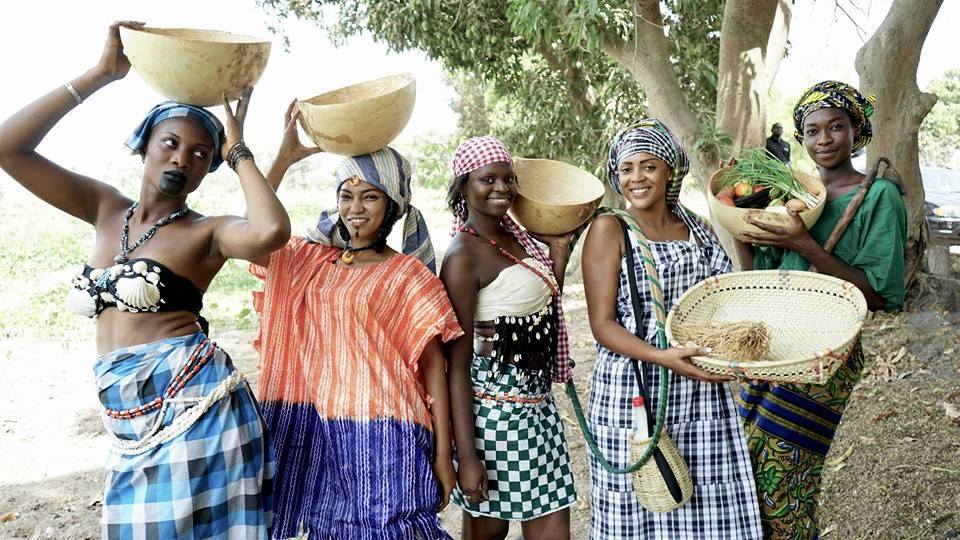
Five Gambian Girls Representing Five Different Tribes;
From the Left: Serere, Fulani, Jola, Wolof, Mandinka.
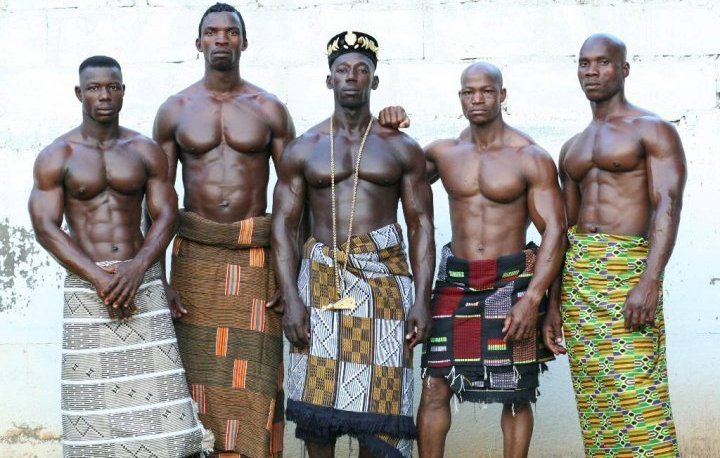
THE ORIGIN OF THE WEST AFRICANS - FROM WHERE DID THEY COME?
The theories about from where these West African peoples originated vary a lot. Lerone Bennett writes; “The West Africans were a bewildering mixture of various stocks. Centuries of contacts and interbreeding had already produced different types. Some of the West Africans were short and broad-nosed. Some were tall with straight hair and aquiline noses. They were all colours; chocolate, asphalt, café au lait, persimmon, cream."
Some of the more tall kind, as the wrestling Serer-guys here below are usually referred to as "Sudan - negroes", and I don´t think anyone knows for sure, but there are theories about them being genetically and culturally related to the East-African Nubians and / or even the ancient Egyptians later having been forced to migrate westwards also because of the gradually increasing dispersal of the Sahara desert.
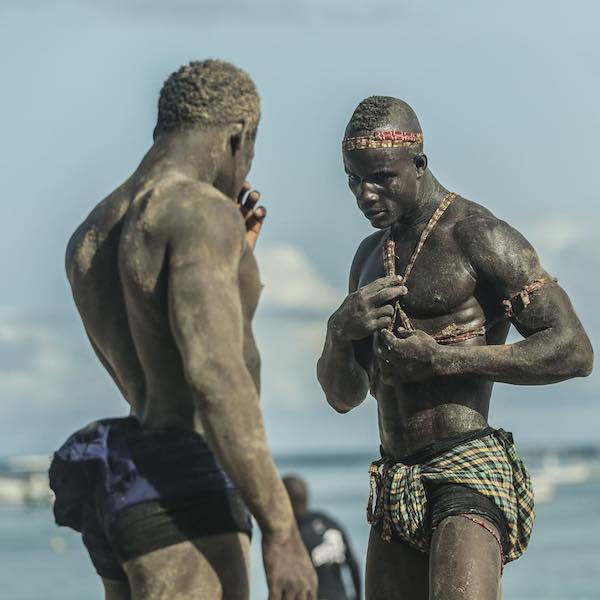
Wrestling Serer-men - a sport they have in common with the ancient Egyptians and Nubians in East Africa
These handsome gentlemen of Serer descent in West Africa still maintain an ancient form of wrestling / martial arts that many assume originated in ancient Egypt. The same kind of martial arts still applies today by the men of East Africa and can be witnessed in ancient Egyptian visual arts. Serer people has to a great extent, still in the 20th century, been matriarchal, which most likely also has been the reason for their long exodus from earlier East African realms, using the strategy of avoidance from their patriarchal persecutors or being pushed westwards by the increasing dispersal of the desert in Sahel.
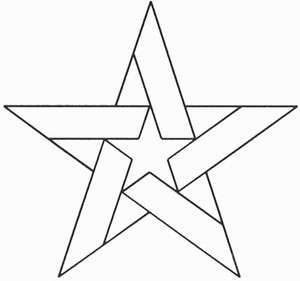 They also share the same religious beliefs regarding the central place of the Sirius star in their cosmology, such as the Dogon people, which also is believed to originate from Egypt. The five-pointed sirius star represented the Egyptian goddess Isis; and has also taken a central place in Sacred Geometry and is a symbol of the female vulva - the wholy gate itself right into the secret place where itself is transformed and created.
They also share the same religious beliefs regarding the central place of the Sirius star in their cosmology, such as the Dogon people, which also is believed to originate from Egypt. The five-pointed sirius star represented the Egyptian goddess Isis; and has also taken a central place in Sacred Geometry and is a symbol of the female vulva - the wholy gate itself right into the secret place where itself is transformed and created.
"Yoonir" among Serer-people means the same as "Yoni" in India / Nepal and is together with the "Linga" combined into a symbol like this venerated in some temples in India and Nepal as a memory from ancient times in the former matriarchal civilisation in the Indus Valley.
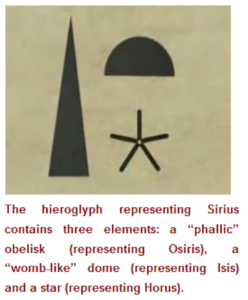
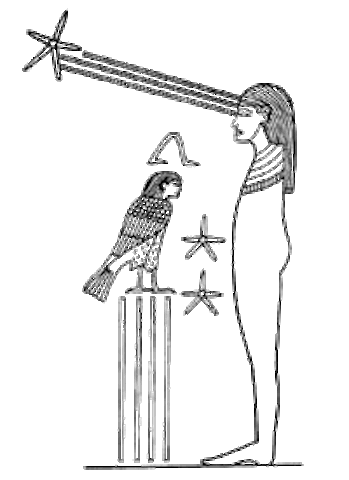
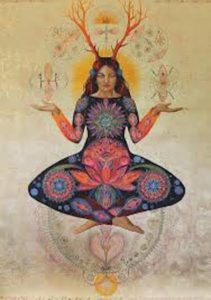
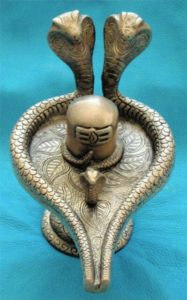
"One of the most important cosmological stars of the Serer people is called Yoonir. The "Star of Yoonir" is part of the Serer cosmos. It is very important and sacred and just one of many religious symbols in Serer religion and cosmology. It is the brightest star in the night sky, Sirius. With an ancient heritage of farming, "Yoonir" is very important and sacred in Serer religion, because it announces the beginning of flooding and enables Serer farmers to start planting seeds. The Dogon people of Mali call it "Sigui", whilst in Serer it is called "Yoonir" - represented in the form of the "Pangool" (interceders with Roog - the Supreme Deity) and "Man".
This is very interesting as the famous ethnologist Cheik Anta Diop pursued the idea that the Dravidian culture in India ones emerged from his own West-African one, as he recognised similarities in the language and religious symbols. I have done the same as the three Goddesses Issa have reported of being venerated in his clan during his upbringing (this must remain secret for a while) Gambia was Sangamar; The Goddess of the See, Ndeban; The Tree Goddess, Kachikali; The Krokodile Goddess
It is before this event where the Serer High Priests and Priestesses known as Saltigue gather at the "Xoy" annual Divination Ceremony where they predict the course of the winter months among other things relevant to the lives of the Serer people. The Pangool (singular : Fangool) are ancestral spirits (also ancient Serer Saints in Serer religion) represented by snakes.
The peak of the Star (top point) represents the Supreme Deity (Roog). The other four points represent the cardinal points of the Universe. The crossing of the lines ("bottom left" and "top right" and "top left and bottom right") pinpoints the axis of the Universe, that all energies pass. The top point is "the point of departure and conclusion, the origin and the end".Among the Serers who cannot read or write the Latin alphabet, it is very common for them to sign official documents with the Star of Yoonir, as the Star also represents "good fortune and destiny".
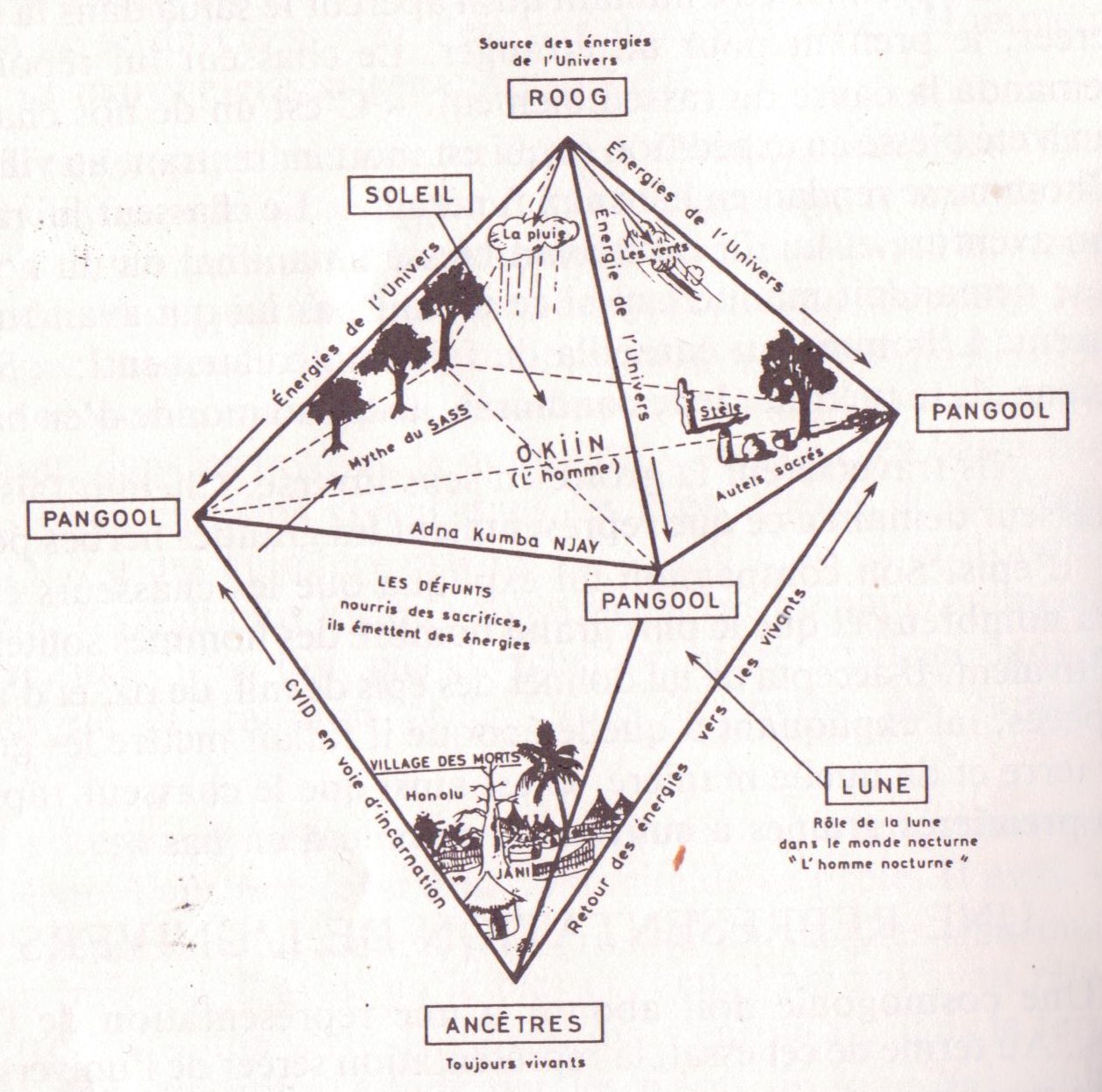
Cosaan Seereer : Xoy Special (2016) - Part 1 : Saturday, 18th June 2016
On Saturday, 4th June 2016 and Sunday, 5th June 2016, the Seereer Resource Centre (SRC) and Seereer Radio's Cosaan Seereer team (Tamsier Joof and Demba Sene) attended the annual Xoy ceremony at Centre MALANGO in Fatick, Senegal. The Xoy is an annual divination ceremony where the Seereer high priests gather once a year before the rainy season to divine the future - mainly about weather conditions, politics and social issues. It is an important festival in the Seereer religious calendar. This is part 1 of the coverage of the Xoy - first broadcast on the Cosaan Seereer show on Saturday, 18th June 2016. Internet connection in Gambia was poor hence why Cosaan Seereer show was cancelled on 11th June 2016 whilst Tamsier was in the Gambia. Following his return back to London, the show was broadcast on 18th June. The audio coverage of the Xoy is rather lengthy. Part 2 is scheduled for Saturday, 25th June 2016. As stated in this audio, the first part is a panel discussion held at Hotel Mindiss in Fatick attended by Dr. Erick Gbodossou (President of Prometra International (Senegal)), Amat Diop (President of CEMETRA), other members of the medical profession and the Senegalese media. The discussion was mainly about the effectiveness of traditional African medicine in curing illnesses. Some Seereer high priests (Saltigi) also provide traditional Seereer medicine. After the panel discussion, Tamsier, Demba and the panelists headed to MALANGO on that same night for the Xoy ceremony where the Seereer priestly class gather to deliver their sermons and divine the future in Seereer. Ablie Bop of Walfadjri Radio translated in Wolof. The Xoy was a two day affair which lasted from 4th to 5th June 2016. If using a computer, the picture to the right is the Seereer star Yoonir (known as Seeseen in Saafi). On the second day of the festival, it was circled by the priestly class and delegations from various parts of Senegal where ritual offerings were made. Visit the Seereer Resource Centre's YouTube channel for a video of this.
T H E M A T R I A R C H A L H I S T O R Y O F W E S T A F R I C A »
T H E A N A R C H I C A L O R G A N I S A T I O N
O F M A T R I A R C H A L Q U E E N R E A L M S »
A K A N A N D A S H A N T E
I N G H A N A A N D T H E I V O R Y C O A S T »
T H E A K A N Q U E E N M O T H E R ´ S M A T R I A R C H A L S Y S T E M S»
M A T R I A R C H A L A K A N K I N G S »
E M E R G I N G P A T R I A R C H A L T E N D E N C I E S I N A K A N R E A L M S »
Back to Homepage:
